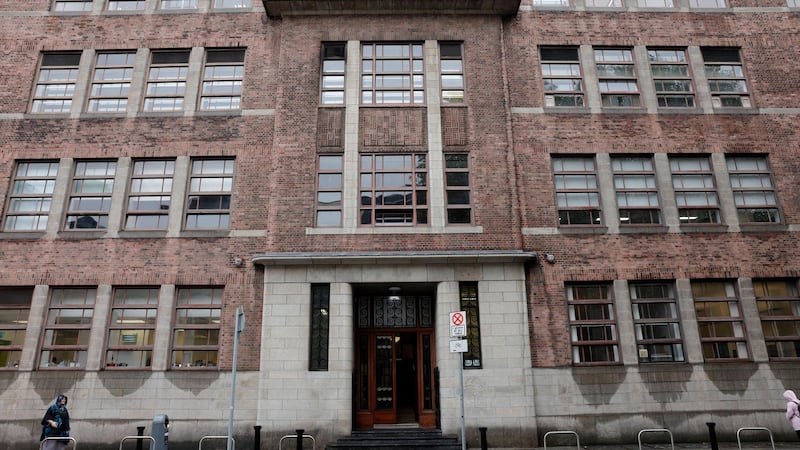The Dublin College of Catering played a central role in the education of Ireland's chefs since opening in 1941, under the name St Mary's College for Domestic Sciences. Over the years, many of the country's best-known chefs passed through its doors and though the college has now moved to the Technological University Dublin (TUD) campus in Grangegorman, the building, on the corner of Cathal Brugha Street and Marlborough Street, remains and its contribution to the city's architecture will continue.
The catering college is arguably one of Dublin’s finest and, it’s fair to say, under-appreciated buildings, with its understated good taste and unfussy fusion of Irish materials shaped by European sensibility. It was built to designs by Robinson & Keefe, who also created the nearby Carlton cinema (1938) on O’Connell Street, and the remarkable art deco Dublin Gas Company on D’Olier Street in 1928 (a building that can truly be considered “two-faced” when you see both its front and rear).
Robinson & Keefe also designed the Technical School, Marino College. Dating a few years before the catering college, it has an endearing little brother feel to the Cathal Brugha Street building by sharing many of its finest features.
Stepping away from the bustle of O'Connell Street and encountering the flat-roofed catering college, you cannot help but look upon it with affection. With its red-brick art deco decorum and its hardwood bay windows set over four storeys, it never insists on anything; its quality and sense of scale is given an elegant flourish, of course, with the Three Graces sculpture by Gabriel Hayes on the west corner. Commissioned by the architects in 1943, Hayes supposedly used three friends as models: one sweeping, one spinning, and one sewing, representing some of the skills taught at the college. The east-facing side also has a chamfered corner for a sculpture, but only Hayes's work was ever set.

Christine Casey’s Dublin volume of The Buildings of Ireland (Yale) calls the catering college a “delightful period piece” with its brightly lit stair hall one of “the most elegantly detailed 20th-century interiors in the city”.
Connemara marble
With further details of its winning combination of applying quality with economy, she adds: “With a simple plan for classrooms to the front and rear of a spinal corridor . . . The vestibule has octagonal columns and Connemara marble cladding . . . a patterned terrazzo imperial stair with chrome-clad steel railings.” Anchoring the college in a vernacular, no-corners-cut classicism are the “Connemara marble, Kilkenny limestone, Irish granite worked in Dublin, and Irish red bricks from Ballinphellic, in Cork”, the latter bestowing the building with a feeling of respectful sympathy towards the nearby St Thomas’s Church of Ireland. The architects had learned a lesson from spirituality, perhaps.
Appreciation for the building was not immediately forthcoming, however. According to the National Inventory of Architectural Heritage, the college was derided in its time for being “parochial”. The inventory has no such qualms about its merits, though, listing the building as “one of the best examples of art deco architecture in the vicinity . . . and remains in remarkable condition, both internally and externally” and “almost all of its high-quality interiors and finishes [are] a testament to the excellence of its design and specification”.
In summation: “It has matured beautifully in its quiet, discreet fashion.”
Originally known as St Mary's College for Domestic Sciences, it was commissioned by the Free State government, and officially opened in June 1941. Its progressive aspirations in education (for Ireland, anyway) were accompanied by some stilted antediluvian sentiments from Archbishop John Charles McQuaid, who announced at the ceremony: "Here will be trained the women who will assist in building happy homes, for there will be imparted the right knowledge and practice of home-craft." The country had a way to go on women's equality following the 1916 Proclamation.
Housewifery
A first intake of students arrived a few months later, in September 1941. TUD’s Dr Brian Murphy, writing in History Ireland magazine, said that among the subjects taught at that time were “art, needlework, laundry, dressmaking and dress design, housewifery, cooking (including institutional and hotel work), the training of chefs and waitresses, applied science, domestic housekeeping, and physical culture”.
Murphy noted the building cost £100,000 (€126,974) at the time of construction. “The college represented the largest capital expenditure investment in an educational project in the State’s short history,” he said.

He added, with some sagacity considering what it fetched when sold in 2018, that “the building has provided enduring value for money”. It was purchased by the Department of Education for a reported €24 million from TUD with the proceeds going towards the development of the Grangegorman campus.
It’s understood the catering college building, including the extension by Gilroy McMahon in 1997, will eventually welcome 1,000 post-primary school children from the north side of the city, although the department said its plans were still “being finalised”.
“It is intended that the property will continue to be used for the provision of education,” a spokeswoman said. “At the moment, part of the property is licensed on a short-term basis to Rehab, which is using it for its National Learning Network to deliver training and support services to people who need specialist support.”
As to whether any of the building’s features will be changed or significantly altered for its new role in education, we will have to wait and see.
The building’s long and fruitful association with the catering college means it will always have one foot in the past. The thousands of students that passed through its deep granite-clad porch will no doubt carry a fondness for the old place. History, meanwhile, records it as one of the better public buildings in the city. People passing by, with just a glance or a proper pause, will continue to admire its heritage and discreet dignity, too, as it sets out on a new era. And the timeless delicacy of the Three Graces will, naturally, remain one of Dublin’s most charming landmarks.












